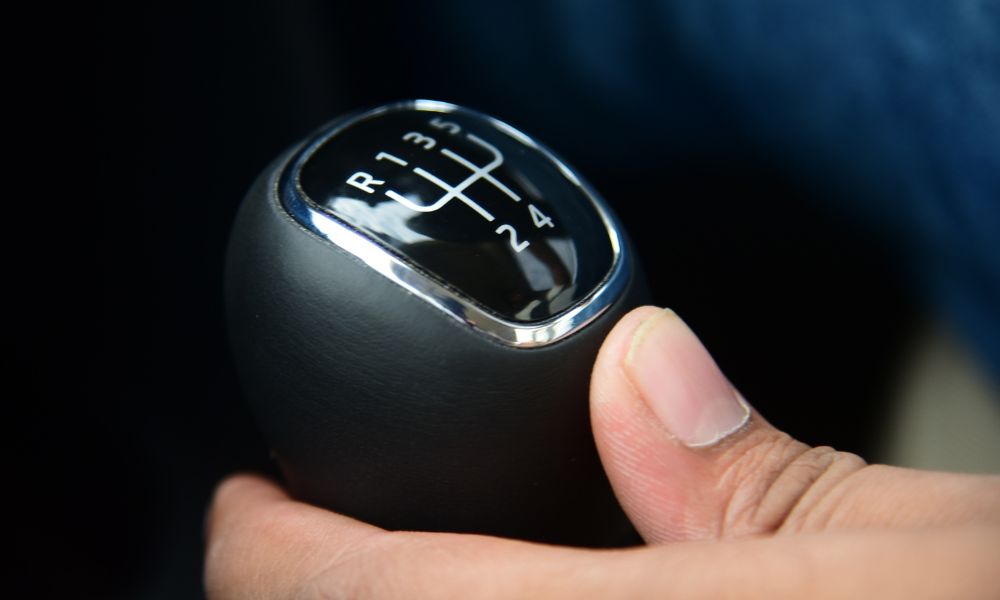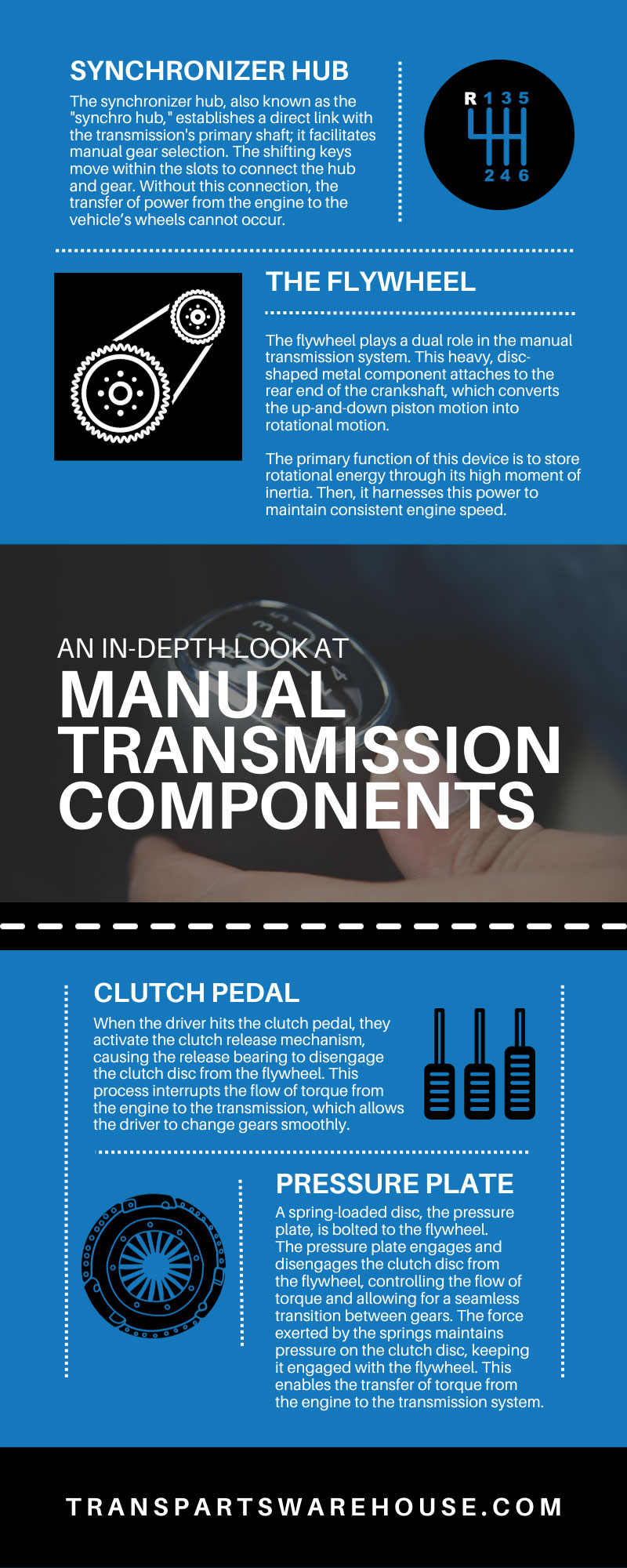
Manual and automatic transmissions are fundamentally different in their operational mechanisms and driver engagement. Automatic cars do all the work for you, while manual transmissions require driver input. That’s why it’s essential to take an in-depth look at manual transmission components so you can thoroughly understand how the system operates.
The Gear Synchronizer
The gear synchronizer maintains shifting by aligning rotational speeds. Without it, the gears would clash or grind and severely damage the transmission, leading to a poor (and dangerous) driving experience. Let’s go over some of the parts that make up the gear synchronizer.
Synchronizer Hub
The synchronizer hub, also known as the "synchro hub," establishes a direct link with the transmission's primary shaft; it facilitates manual gear selection. The shifting keys move within the slots to connect the hub and gear. Without this connection, the transfer of power from the engine to the vehicle’s wheels cannot occur.
Synchronizer Sleeve
The synchronizer sleeve is just as crucial as the synchronizer hub in the shifting process. The cylindrical device guarantees seamless gear changes as it slides back and forth along the hub. The sleeve moves toward the desired gear as the driver initiates the change. The result is an efficient transmission system that shifts flawlessly.
Ring Spring
The ring spring is small and often overlooked. It sits within the synchronizer assembly and maintains the alignment and positioning of the shifting keys. Maintaining tension permits the ring spring to create undisrupted movements along the hub. The transmission will perform well and endure little wear with a fully functional ring spring.
Baulk Rings
The baulk rings are cone-shaped components attached to the gears. When the driver changes gears, the synchronizer sleeve engages with the corresponding baulk ring. This interaction equalizes the rotational speed of the gear with that of the synchronizer sleeve.
The primary function of the baulk rings is to prevent gear engagement if the speeds are not synchronized. The goal is to create a smooth shifting process that protects the transmission system from damage.
Synchronizer Cone
The synchronizer cone, or friction cone, sits on the exterior of the gear. When a gear change begins, the synchronizer sleeve pushes the baulk ring against the synchronizer cone. The frictional forces between these two components equalize the speed. This process is crucial for seamless gear changes and to protect the transmission from excessive wear.
The Flywheel
The flywheel plays a dual role in the manual transmission system. This heavy, disc-shaped metal component attaches to the rear end of the crankshaft, which converts the up-and-down piston motion into rotational motion.
The primary function of this device is to store rotational energy through its high moment of inertia. Then, it harnesses this power to maintain consistent engine speed.
The flywheel functions as the mounting surface for the clutch disc during engagement. The friction surface of the flywheel connects directly with the clutch disc to enable the transfer of engine torque to the transmission system.
The Clutch
The clutch is the direct link between the engine and the transmission. It's responsible for transmitting torque from the engine to the transmission system, controlling the vehicle's power output. The clutch engages when the driver changes gears, and it briefly disconnects the engine from the transmission during this process to allow for smooth shifting.
Clutch Pedal
The clutch pedal is located on the floorboard of the driver’s seat. There are three pedals present instead of the two seen in automatic vehicles. Unlike most manual transmission parts, the driver directly interacts with the clutch pedal. This component allows the driver to control the engagement and disengagement of the clutch.
When the driver hits the clutch pedal, they activate the clutch release mechanism, causing the release bearing to disengage the clutch disc from the flywheel. This process interrupts the flow of torque from the engine to the transmission, which allows the driver to change gears smoothly.
Releasing the pedal engages the clutch disc with the flywheel again. Torque transfer occurs and permits the vehicle to move. With this resourceful feature, the driver possesses full control over the vehicle’s shifting operations.
Release Fork
The release fork is the mechanical intermediary between the clutch pedal and the clutch assembly. When the clutch pedal is depressed, it triggers the release bearing to move, facilitated by the release fork.
This device leverages the force from the clutch pedal and translates it into the movement of the release bearing. This process initiates disengagement, separating the clutch disc from the flywheel and interrupting the torque flow from the engine to the transmission system for responsive gear shifts.
Clutch Disc
The clutch disc manages the flow of torque from the engine. It lies between the flywheel and the pressure plate. When the driver engages the clutch disc, it locks onto the flywheel and enables the transmission of torque.
The friction material rests on both sides of the disc. Therefore, the piece always guarantees a strong and reliable connection to transmit torque.
When the clutch pedal is depressed, the pressure plate disengages from the clutch disc to disconnect from the flywheel. This interrupts the transmission of torque and permits a seamless gear change. Clutch discs are heat resistant and very durable. Their incredible composure makes them vital for improved transmission performance.
Pressure Plate
A spring-loaded disc, the pressure plate, is bolted to the flywheel. The pressure plate engages and disengages the clutch disc from the flywheel, controlling the flow of torque and allowing for a seamless transition between gears. The force exerted by the springs maintains pressure on the clutch disc, keeping it engaged with the flywheel. This enables the transfer of torque from the engine to the transmission system.
When the clutch pedal is depressed, the pressure applied by the plate releases and disengages the clutch disc from the flywheel. This withdrawal interrupts the flow of torque, allowing the driver to change gears.
Manual transmissions are complex machines. They contain many moving parts that require skill to operate. Gaining in-depth knowledge about manual transmission components is a good way to start learning how to drive a manual vehicle.
Transparts Warehouse is full of information, aftermarket transmission parts, and skilled team members who are ready to assist you. Manual transmission replacement parts are valuable for your automotive endeavors, whether you want to learn how to drive manual cars or repair them.



